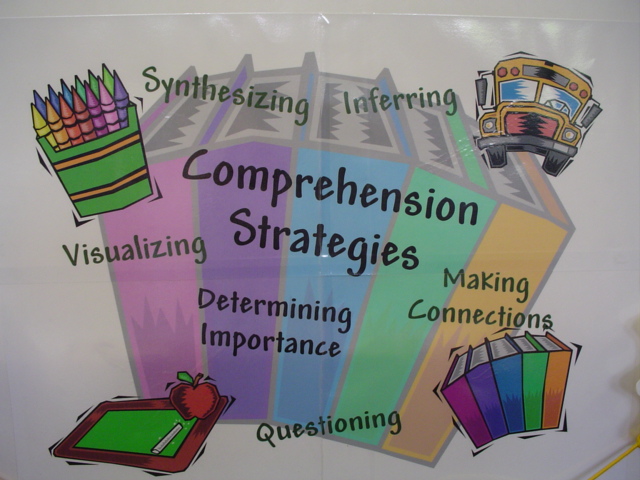
Visualizing |

Planting a
Literacy Garden |

Questioning |

Synthesizing
|
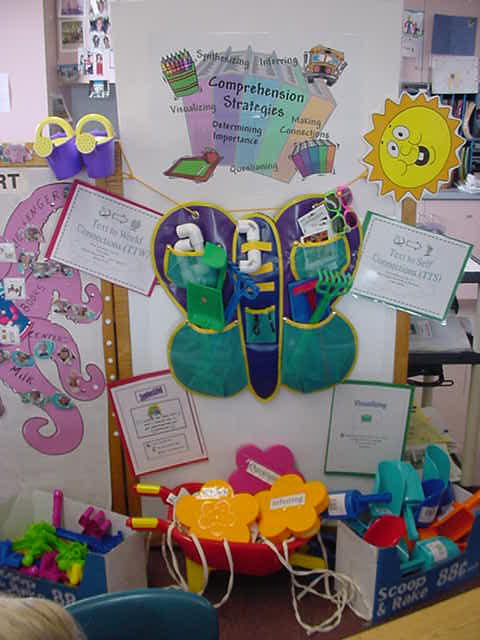
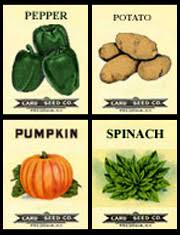
Making Connections/Schema |

Inferring |

Determining Importance
|

Digging For Meaning |

In 2004 I began attending a 3-year Literacy Coaching Class at our
local educational collaborative that offered the opportunity to work
collaboratively
with my colleagues to become part of a statewide initiative sharing
best practices teaching comprehension strategies in a lab classroom
setting.
 |
1.We have extended the
repertoire of strategies for district colleagues,
preservice teacher candidates and enable others to view and glean
current best teaching practices and strategies that in turn impacts
our
student’s ability to earn and develop comprehension strategies.
|
 |
2. Through integrating
content areas, we help to infect all involved educators
in more effective, child-relevant curriculum design while finding
ways to
include rigorous science instruction in this time of mandated time
schedules
to meet the criteria of No Child Left Behind.
|
 |
3. Having visitors has
helped because the positive feedbacks at post
observations have authenticated many of our choices and/or given
us ideas for fine-tuning this approach. |
Student achievement is
impacted in several ways
 |
1. The hands on science
activities are both motivating and stimulating for children as they read
and write about gardening and respond to other literature.
|
 |
2. We drive instruction with the use of
hands-on developmentally appropriate
tools that include all learners because we combine “tools”, sunglasses
(for visualizing), seeds (relate to prior
knowledge/schema), plastic shovels (to model digging for meaning), rakes
(for questioning), hoes (help us determine importance), watering cans (are
the synthesizing agent), and a picture of the sun (shines light on
inferring), with the acknowledgement of the student’s prior knowledge of
gardening.
Students can’t wait to get their hands dirty, use real tools, and
produce/nurture
the real-life garden.
|
 |
3. We invite
parents as partners into the classroom to model effective literacy
practices so parents can continue to model the same language at home. |
 |
This teaching theme is a developmentally appropriate
hands-on
learning sequence, designed for teachers in the early primary grades (K-2)
who want to incorporate comprehension strategies into their literacy
curriculum.
To better understand the comprehension strategies used to enhance
your literacy curriculum, begin by reading these books as reference.
Click to buy these books:
|
 |
Mosaic Of Thought by Ellin Oliver Keene.
|
 |
Strategies That Work by Stephanie Harvey and Anne Goudvis |
 |
Starting With Comprehension by Andie Cunningham and Ruth Shagoury. |
 |
Seven Keys to Comprehension by Susan Zimmermann and Chryse Hutchins |
 |
Kid
Writing Strategies developed by Feldgus and Cardonic.
Before beginning each lesson, teach your students this song
to help them remember the strategies.
|
|

Planting A Literacy Garden
(Cover) |
(Page 1, Literacy Garden Grid),
Using this grid, students will color each section to show
which page they have completed. |

(Page
2, My Favorite Book),
After reading many selections, have students choose their
favorite book to illustrate and write about. |

(Page 3, Fairy
Tales)After reading several fairy tales, have
students choose a favorite one to illustrate and write about. |
| (Page 4, My
Favorite Author),
After reading books by several authors, have students
choose their favorite author and draw a picture of one favorite book by
them.
|
(Page 5, My
Favorite Poem) After reading several poems, have
students choose their favorite poem to illustrate and write about.
|

(Page 6, Inferring)
Have students write about an idea that the author wants
them to know but was not literally present in the text. |

(Page
7, Questioning)Have students write one lingering
question about the read aloud. |

(Page 8, Synthesizing)
Have students write about a new idea they have conceived
after reading aloud. |
 
(Page 9, Visualizing)
To help your students visualize words while
reading aloud, have them wear a pair of child's sun glasses. |
|
Page 10, Determining
Importance Have students look at maps, charts,
graphs to help
determine the importance of the text. |
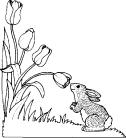
Page 11, Making
Connections/SchemaHave students make a
connection to their past as you read aloud. |
|
(Page 12, Biography)
Have students write about their lives.
|
(Page 13, Auto Biography) Have
students write about one favorite person in their life. |
 
Page 14. My Memoir
Have students remember one moment in time and capture that in a
picture and short paragraph.
|
Please comment and let me know
how this program is impacting your students.
Comment Form |
Click here on the Strategies
page to help you understand the guiding relevant factors you should
consider when teaching.
For a word document to print of the
Strategies, click here.
To help students understand the strategies,
give each child their own tool belt. I bought individual tool belts at Home
Depot for 99 cents a piece. Inside the tool belts I neatly placed various
plastic gardening tools. Each tool is a tactile representation of the
strategies. On each shovel (digging for meaning) I taped twenty-five every day
functional sight words that students can use when they Kid Write. As students
"dig for the meaning of the story" they use the words on the shovel to create
their sentences.
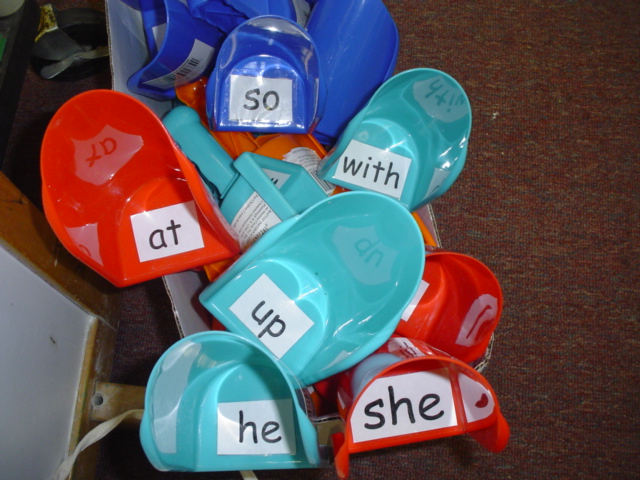
View the twenty five sight words here.
I bought little boxes that are shaped like flowers and inside the boxes I placed
words that
students use when writing their stories. Each box contains words based on
a particular strategy.
Click on the word list below to print out a copy of the words to place in your
flower boxes.

Words for Questioning
As rakes push dirt aside
and leave gaps in the ground, unanswered questions leave gaps in our
understanding. These gaps in one's understanding can be filled by asking
questions. Words students use to ask questions can be found in the Questioning
Box.
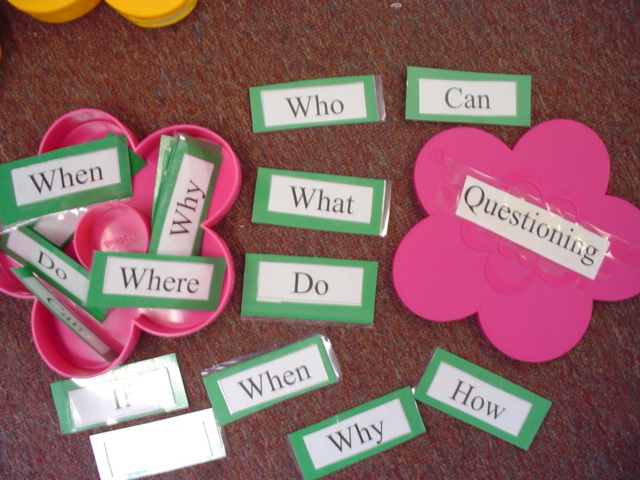
Words for Inferring
As students dig for meaning and ask
questions, they can make inferences that leads them to
understanding an idea the author wants the reader to know without writing it in
the text. Words
that help students to infer are in the Inference box.


Words for Visualizing
As they listen to a read aloud, or as
they read text they wear sunglasses.
The importance of visualizing and seeing the picture that is
playing in their mind is heightened and brought to life with the glasses.
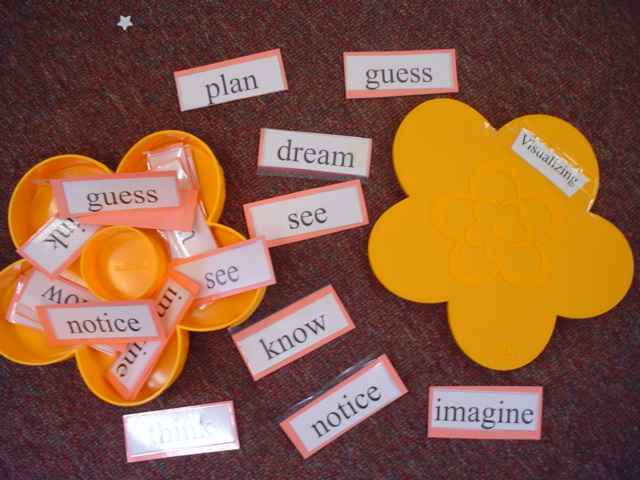
Use these Rubrics on the left developed by Ellin O. Keene to help assess your students literacy development
while teaching comprehension strategies. The rubrics on the right were
created for Kindergarten levels.
Rubric for
Visualizing
Kindergarten Rubric for
Visualizing
Rubric for
Questioning Kindergarten
Rubric for Questioning
Rubric for Inferring
Kindergarten Rubric for Inferring
Rubric for
Determining Importance
Kindergarten Rubric for Determining Importance
Rubric for Retelling
Kindergarten Rubric for Retelling
Rubric for
Synthesizing
Kindergarten Rubric for Synthesizing
Rubric
for Monitoring Comprehension
Kindergarten Rubric for Monitoring Comprehension
Rubric for
Think Alouds Kindergarten Rubric for Think Alouds
Rubric for Using
Schema Kindergarten Rubric for Using Schema
After I created Planting A Literacy Garden, I
created a website that uses Eric Carle's books.
If you are interested in
integrating technology into your literacy curriculum
while studying Eric Carle as an author, click on Carleworks below.
Lessons were created that integrate technology based on building five literacy
skills of Phonemic Awareness, Phonics, Vocabulary, Fluency and Comprehension.
The website contains a Power Point to help develop the skills.
Carleworks

Please feel free
to use any of my work and email me and let me know if this has made an impact on
your students learning.
Thanks for visiting!
